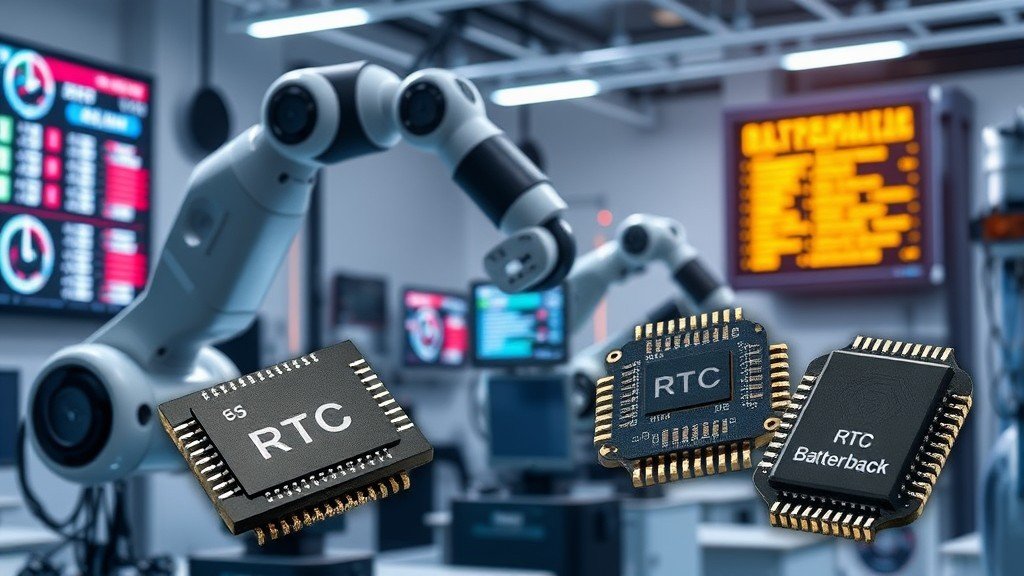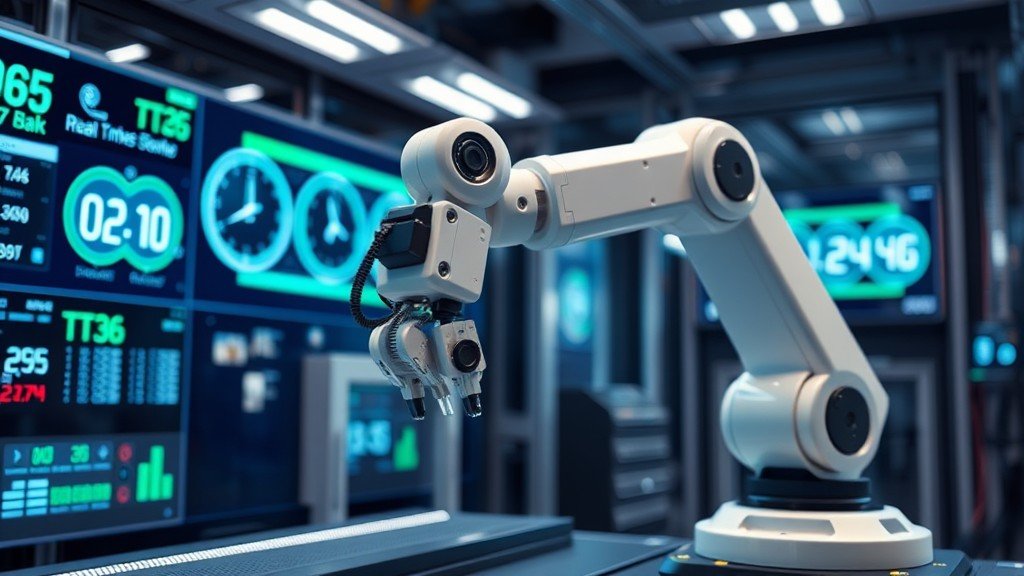An RTC, or Real-Time Clock, is very important in robotics. It helps robots know what time it is and when to do certain tasks. This is really helpful for many jobs that robots perform.(1)
Keep reading to learn more about how RTCs work and why they are great for robots! You’ll discover how these clocks help robots stay on schedule and complete their tasks effectively.
Key Takeaway
- RTCs keep accurate time for robots to do tasks.
- They work even when there is no power.
- Robots use RTCs in many ways, like for home automation and data logging.
Understanding Real Time Clocks in Robotics
Credits: gregory corbett
Robots use special tools called real time clocks (RTCs) to help them keep track of time. RTCs tell robots exactly when to start doing something, when to stop, or when to switch to a new task. This is very important for robots!
Here’s why RTCs matter:
- Robots often need to move their arms, legs, or wheels at just the right time. RTCs make sure they do it perfectly.
- Without RTCs, a robot might move too early or too late. This could make it less efficient or cause mistakes.
- RTCs help robots coordinate their movements and tasks. This allows them to work smoothly and do their jobs well.
- For example, if a robot needs to lift a box at a certain moment, its RTC will alert it exactly when to close its gripper and start lifting.
So in summary, RTCs give robots accurate timing. This helps robots perform tasks properly and work better overall. RTCs are an essential tool for coordinating a robot’s motions and behaviors. They help robots stay on schedule and operate efficiently.
Functionality of RTC in Robotics

Here are some key ways that real time clocks (RTCs) help robots function properly:
- RTCs give robots accurate timing. This allows robots to perform actions at exactly the right moment. Precise timing is crucial for many robot tasks.
- Some RTCs have built-in batteries. This lets robots keep track of time even if the main power goes out. Robots can stay on schedule without stopping.
- RTCs help robots coordinate complex sequences of motions. The robot can use the RTC to know when to start each movement in a series. This improves efficiency.
- With good timing from the RTC, robots can avoid safety issues like moving too fast near people. The RTC helps the robot moderate its speed and actions.
- In summary, RTCs bring key benefits to robots:
- Precise timing for better task performance
- Ability to work independently without constant power
- Coordination for smooth sequences of motions
- Improved safety through controlled speed and actions
RTCs are an essential tool for robots. By giving them accurate timekeeping, RTCs help robots work reliably, efficiently, and safely. They are a key component enabling robots to function well in many settings.
Applications in Robotics
Here are some common ways robots use real time clocks:
- Robots in factories rely on RTCs to time their motions perfectly. This allows them to assemble products or package items without errors. The RTC helps them move at just the right speed.
- In agriculture, robots may use RTCs to know when to water crops or capture images of them. The RTC allows them to follow the optimal schedule.
- Robots that explore dangerous places like volcanoes can use RTCs to record sensor data at regular intervals. This creates a detailed log for scientists to analyze.
- In hospitals, robot helpers can use RTCs to move patients on a set schedule. The RTC helps coordinate patient care.
- At home, RTCs help robot vacuums start cleaning at the time you set. The RTC allows the vacuum to clean daily on its own.
- For self-driving vehicles, RTCs help coordinate when to brake, accelerate, and steer. This safe driving depends on accurate timing.
So in summary, RTCs give robots precise timing for all kinds of important tasks and behaviors. They are a key tool for coordination in many robotics applications.
Specific Examples of RTC Use
Here are two specific examples of how real time clocks (RTCs) are used in robotics:
Dancing Robots
- Humanoid robots can dance to music using RTCs.
- The RTC module (like a DS3231) helps the robot move perfectly in sync with the beat.
- When the music stops, the RTC tells the robot to stop dancing immediately.
- This timing accuracy from the RTC lets the robot look smooth and coordinated while dancing.
Modular Robot Components
- Many robots are built using modular parts that can be combined in different ways.
- These components need to work together seamlessly for the robot to operate.
- RTCs help synchronize the modules so they interact properly during tasks.
- With the RTC, the components start and stop at the right times to complete jobs.
So in both dancing robots and modular robot systems, RTCs are key for coordination and timing. They help robots perform smoothly and effectively. RTC are an essential technology for many robotics applications.
Why Real Time Clocks are Important for Robots
Real time clocks (RTCs) are very useful for robots! Here are 3 reasons why:
- RTCs help robots keep perfect time. This lets robots schedule tasks and work together easily.
- RTCs don’t use much power. This means robots can work longer before needing to recharge.
- RTCs are usually accurate. They might lose or gain a few seconds, but that’s ok for robots.
So in summary, RTCs help robots in 3 big ways:
- Keeping precise time
- Using less energy
- Being reliable
That’s why RTCs are so important for robots! They help robots work smoothly and efficiently.
Additional Features of RTCs
RTCs don’t just tell the time – they have extra cool features too! Here are 2 examples:(2)
- Alarms and Timers – Some RTCs can set alarms for robots. This helps robots do important stuff right on time.
- Time Synchronization – RTCs can sync up with other time sources. This helps groups of robots work together at the exact same time.
With handy extras like these, RTCs become even more useful for robots. They help robots:
- Keep perfect track of time
- Save energy
- Work reliably together
That’s why RTCs and their extra features are so great. They make robots even better at all the things they need to do!
Conclusion
RTCs are essential for robotics. They enable robots to keep accurate time, function without power, and perform many important tasks. As robots continue to advance and assist in various fields, RTCs will remain a vital part of this technology.
FAQ
What is an RTC robot and how does it use an RTC module for automated tasks?
An RTC robot is a type of robot that uses a Real-Time Clock (RTC) module to keep track of time. This helps the robot know when to do certain tasks. For example, with an RTC module like the rtc ds1307 or rtc ds3231, the robot can perform actions automatically at specific times. This is really important for things like preparing samples or changing tools, where timing matters a lot.
How does the RTC ds1307 compare to the RTC ds3231 module in robotics applications?
The rtc ds1307 and rtc ds3231 are both popular RTC modules used in robotics, but they have some differences. The rtc ds3231 is more accurate and has features that help it keep time better, even when temperatures change. This makes it great for complex robotic tasks. On the other hand, the rtc ds1307 is simpler and less precise. Both modules can be used in different robotics platforms to help robots keep track of time and perform tasks correctly.
What role does a real-time clock play in robotic technology components?
A real-time clock (RTC) is very important in robotic technology because it helps robots keep accurate time. This timing is crucial for robots that need to do things at specific moments. For example, in fully automated systems, like those that prepare samples or change tools, the RTC ensures everything runs smoothly and on schedule. This accuracy is essential for making sure robots work effectively.
How can Raspberry Pi integrate with RTC modules for robotics projects?
Raspberry Pi can work well with RTC modules like the rtc ds1307 or rtc ds3231 to improve its performance in robotics projects. By adding an RTC module, Raspberry Pi can keep accurate time even if the power goes out. This feature allows developers to create systems that perform tasks automatically at the right times, such as controlling devices or scheduling activities. Using these tools helps make robotic projects more efficient and reliable.
What are some tools and modules used alongside RTCs in robotics?
In robotics, many tools and modules work together with RTCs to make robots function better. Common components include microcontrollers like Arduino or Raspberry Pi, which connect to RTC modules such as the rtc ds1307 or rtc ds3231. Other useful tools might include sensors for gathering data, motors for movement, and communication devices for sharing information. Together, these components help create strong robotic systems that can handle tasks like sample preparation efficiently.
Where can I find research on real-time clocks in robotics using Google Scholar?
You can find research about real-time clocks (RTCs) in robotics by searching Google Scholar with terms like “robotic RTC” or “real-time clock in robotics.” This site gives you access to academic papers and articles about new developments in robotic technology. You might also discover studies about how RTCs are used in automated tasks at international conferences focused on computer science and engineering topics.
References
- https://pwbotics.wordpress.com/2020/01/22/rtc-real-time-clock/
- https://roboticsleb.com/comprehensive-guide-to-ds1307-rtc-module-with-arduino/


